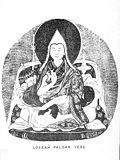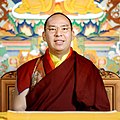List
| Title | Portrait | Name (Lifespan) | Recognition | Tibetan Wylie transliteration | THL and other transliterations | References |
|---|---|---|---|---|---|---|
| 1st Panchen Lama |  | Khedrup Gelek Pelzang (1385–1438) | posthumously | མཁས་གྲུབ་རྗེ། mkhas grub rje,་ མཁས་གྲུབ་དགེ་ལེགས་དཔལ་བཟང་པོ། mkhas grub dge legs dpal bzang po | Khédrup Gélek Pelzangpo Khädrup Je Khedrup Gelek Pelsang Kedrup Geleg Pelzang Khedup Gelek Palsang Khedrup Gelek Pal Sangpo | |
| 2nd Panchen Lama |  | Sönam Choklang (1438–1505) | posthumously | བསོད་ནམས་ཕྱོགས་ཀྱི་གླང་པོ། bsod nams phyogs glang,་ བསོད་ནམས་ཕྱོགས་ཀྱི་གླང་པོ་ bsod nams phyogs kyi glang po | Sönam Chok kyi Langpo Sonam Choglang Soenam Choklang | |
| 3rd Panchen Lama |  | Ensapa Lobsang Döndrup (1505–1568) | posthumously | དབེན་ས་པ་བློ་བཟང་དོན་གྲུབ། dben sa pa blo bzang don grub | Wensapa Lozang Döndrup Gyalwa Ensapa Ensapa Lozang Döndrup Ensapa Losang Dhodrub | |
| 4th Panchen Lama |  | Lobsang Chökyi Gyalsten (1570–1662) | 1645–1662 | བློ་བཟང་ཆོས་ཀྱི་རྒྱལ་མཚན། blo bzang chos kyi rgyal mtshan | Lozang Chö kyi Gyeltsen Losang Chökyi Gyältsän Lozang Chökyi Gyeltsen Lobsang Chökyi Gyaltsen Lobsang Choekyi Gyaltsen Lobsang Choegyal Losang Chögyan | |
| 5th Panchen Lama |  | Lobsang Yeshe (1663–1737) | 1663–1737 | བློ་བཟང་ཡེ་ཤེས། blo bzang ye shes | Lozang Yéshé Lobsang Yeshi Losang Yeshe | |
| 6th Panchen Lama |  | Lobsang Palden Yeshe (1738–1780) | 1738–1780 | བློ་བཟང་དཔལ་ལྡན་ཡེ་ཤེས། blo bzang dpal ldan ye shes | Lozang Penden Yéshé Palden Yeshe Palden Yeshi | |
| 7th Panchen Lama |  | Palden Tenpai Nyima (1782–1853) | 1782–1853 | དཔལ་ལྡན་བསྟན་པའི་ཉི་མ། pal ldan bstan pa'i nyi ma | Penden Tenpé Nyima Tänpä Nyima Tenpé Nyima Tempai Nyima Tenpey Nyima | |
| 8th Panchen Lama |  | Tenpai Wangchuk (1855–1882) | 1857–1882 | བསྟན་པའི་དབང་ཕྱུག bstan pa'i dbang phyug | Tenpé Wangchuk Tänpä Wangchug Tenpé Wangchuk Tempai Wangchuk Tenpey Wangchuk | |
| 9th Panchen Lama |  | Thupten Chökyi Nyima (1883–1937) | 1888–1937 | ཐུབ་བསྟན་ཆོས་ཀྱི་ཉི་མ། thub bstan chos kyi nyi ma | Tupten Chö kyi Nyima Choekyi Nyima Thubtän Chökyi Nyima | |
| 10th Panchen Lama |  | Choekyi Gyaltsen (1938–1989) | 1938–1989 | བློ་བཟང་ཕྲིན་ལས་ལྷུན་གྲུབ་ ཆོས་ཀྱི་རྒྱལ་མཚན། blo bzang phrin las lhun grub chos kyi rgyal mtshan | Lozang Trinlé Lhündrup Chö kyi Gyeltsen Choekyi Gyaltsen Chökyi Gyeltsen Choekyi Gyaltse Trinley Choekyi Gyaltsen Lozang Trinlä Lhündrup Chökyi Gyältsän |


